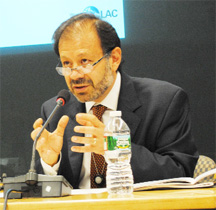China’s role in Latin America and the Caribbean (LAC) will need to adapt and evolve if it is going to have a lasting, positive impact, a new World Bank report has said.
The report, titled ‘Latin America and the Caribbean’s Long-Term Growth: Made in China?’ noted that the region’s relationship with the Asian giant has proved to be a critical source of stability, both during the global economic crisis of two years ago, but questions whether it can be sustained over the long term, a press release from the World Bank said.
The bank’s Chief Econo-mist for the region, Augusto de la Torre, who led the preparation of the report, said that there is little evidence that China can play a role in fostering productivity growth for Latin America and the Caribbean. Noting the lacklustre economic performances in the US and Europe, he said that one key question was whether LAC could leverage its deepening connection with China and turn it into an important source of long-term growth.

The study on which the report is based, took an in-depth look at the China-LAC relationship, particularly as it compares to Japan’s interactions with East Asian economies from the 1970s to the 1990s.
It noted that while the “golden years of the East Asian Tigers were characterized by large flows of intra-industry trade and foreign direct investment from Japan, with significant distribution of technology and knowledge more broadly”, the first decade of China relations with LAC lacked much of that promising exchange.
Acknowledging that China has become the principal trading partner for some large LAC countries, the report stated that trade between China and these nations revolved around the exchange of the region’s abundant natural resources for “low-tech goods from China that are labour-intensive to produce”. This type of trade typically limits the potential gains from technology and knowledge sharing, it added.
But this does not mean, it stated, that there have been no gains from the commodity boom in the region. It noted that China has been the driver of “robust growth over the past decade” in LAC and, resulting in stability that allowed the region to sidestep the global economic crisis of two years ago as well as the current market turmoil that is rolling across Europe and the United States.
“Some bright spots show that certain commodity sectors in LAC are benefiting from technological innovation and generating local, quality employment,” the report said.
However, it noted, until these favourable conditions become more widespread, it would be difficult to expect that the region will finally begin narrowing the gap with advanced nations. LACs growth performance over the 20th century was rather dismal with per capita income remaining largely steady at 30 per cent of the US In contrast, East Asian countries saw their per capita income, which was only about 15 per cent that of the US in the 1960s, rise sharply and steadily to reach more than 70 per cent of the US by 2010.
“The very fact that the region is confronted at this stage with inflationary pressures arising from strong economic activity is a clear reminder that the region tends to bump against structural speed limits at comparatively low growth rates,” the report said.
While the high-performing economies of emerging Asia can sustain annual growth rates in the 6-9 per cent range without inflationary consequences, in most of LAC the non-inflationary growth rates that can be sustained over long periods hover below 5 per cent, it added.
In the short term, it noted, growth forecasts for LAC have remained positive between 3.5 and 4.5 percent for 2011 and 2012 and inflation rates are expected to stat between 6 and 7 per cent this year. Perceptions of sovereign risk continue to be relatively low for the region. In fact, in an unprecedented development, markets now perceive that the sovereign debt default risk of several countries in LAC including Chile, Colombia, and Peru is lower than that of France, the report said
However, huge disparities remain. The World Bank report pointed out the most obvious: road density in LAC has declined 15 per cent since the 1980s, while it has expanded 30 per cent in the Asian countries; LAC’s electricity installed capacity was about 17 per cent below that of the Tigers in the 1980s. Now it is almost 50 per cent below; LACs percentage of population with tertiary education has risen from 9.5 per cent in 1990 to 14.2 per cent in 2009, but it pales relative to the Tigers, which has gone from 10 to 20 per cent in the same period.
However, the release quoted de la Torre as stating that vibrant democratic systems, in the long term, can contribute to ensure that progress in these key areas is sustainable.




